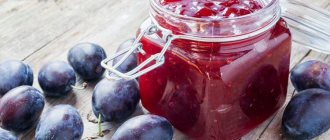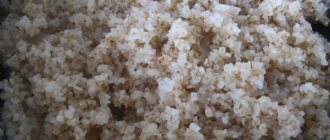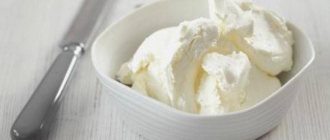A little bit of history
In ancient times, brown sugar crystals, extracted from cane, became the first sugar that people began to enrich their diet with. The first mentions of this wonderful plant date back to the times of Alexander the Great. India is considered to be the birthplace of cane sugar, from which this product spread throughout Europe. In the 16th century, brown cane sugar was a symbol of luxury and wealth. This product, which became the cause of wars of conquest, was an integral guest of the royal table. In modern times, brown sugar is not something unusual or outlandish, because everyone can afford to buy it.
Calorie content of different types of sugar
| Type of sugar | Calories per 100 grams | What does it look like | Value for the body |
| Beetroot | 362 kcal. | White translucent crystals. | Gives glucose and sugar. |
| Reed | 377 kcal. | Crumbly, brownish, has the smell of molasses. | Contains 5 B vitamins, microelements, including calcium, magnesium, iron, potassium. |
| Palm | 390 kcal. | Pale or deep brown in color, semi-powdery, tastes like coffee plus caramel. | Contains amino acids and has a low glycemic index (white has 70, palm has only 30!). |
| Malt | 362 kcal. | Light brown, yellowish. Crumbly or cylindrical in shape with a rough surface of the cubes. | Made from wheat, it is an excellent source of energy and vigor. Contains amino acids, phosphorus and zinc, vitamins. |
| Sorghum | 339 kcal. | Transparent yellowish syrup, the consistency resembles liquid honey. | An ideal eco-friendly sweetener for porridges and mousses. There is no fat in it, there is a minimum of fructose and many microelements. |
| Maple | 260 kcal | The syrup is dark brown. | High content of calcium and iron. No unhealthy fats or sucrose, only glucose. |
| Fruit | 399 kcal | White powdery | There are no obvious ones. In increased doses for weight problems, it can cause obesity. |
| Sugar candis | 394 kcal. | Transparent brown cubes with a smooth surface, reminiscent of a candy cane. | Mild taste, aesthetic value, melts longer than other types. |
White and brown sugar: what are the differences?
Brown sugar has a number of undeniable advantages compared to its white counterpart. White sugar is a refined product obtained by chemically processing brown sugar. To obtain it, various bleaching agents are used, some of which, “settling” in white sugar, penetrate into the human body with it. Brown sugar, the recipe for which does not require this kind of purification, is more natural and environmentally friendly.
The brown color of sugar is due to the presence in its composition of components such as molasses or molasses, which contain a lot of useful minerals. Therefore, brown cane sugar is significantly ahead of white sugar in terms of biological value.
How many calories are in sugar per 100 grams, calorie content and BJU of granulated sugar
Sugar and other sweeteners were inaccessible to ordinary people in the Middle Ages, since their extraction took place in a rather complex way.
Only when sugar began to be produced from beets did the product become available to the middle and even poor segments of the population. At the moment, statistics believe that a person eats about 60 kg of sugar per year. These values are shocking, considering that the calorie content of sugar per 100 grams is about 400 kcal.
You can reduce calorie content by consuming certain sweeteners; it is better to choose natural formulations rather than drugs purchased at the pharmacy.
Next, the calorie content of sugar and its various varieties will be presented in detail, so that everyone can make their choice in favor of a less calorie product.
Calorie content of sugar
The total calorie content and BJU of sugar can be presented in the table:
| Calorie content, kcal | Proteins, g | Fats, g | Carbohydrates, g |
| 398 | 0,0 | 0,0 | 99,7 |
From the above it follows that it is recommended to reduce consumption of the product - this is also justified by the composition.
Appearing as:
- about 99% of the total amount in the composition is given to mono- and disaccharides, which give the calorie content to sugar and sweetener,
- the remainder is given to calcium, iron, water and sodium,
- Maple sugar has a slightly different composition, which is why its calorie content does not exceed 354 kcal.
It is better to purchase maple sugar only from producers from Canada, since this country can ensure the quality of the product.
About calories in a spoon of sugar
To accurately determine the number of calories in a cooked dish, you must provide the following data and values:
- a tablespoon holds 20 g of product,
- provided that there is a heaping tablespoon of product, there will be 25 g,
- 1 g of granulated sugar contains 3.99 kcal, so one level tablespoon contains 80 kcal,
- if the spoon of the product is topped, then the calories increase to 100 kcal.
When preparing dishes with the addition of granulated sugar, if you want to lose weight, the energy value of the product should be taken into account.
About calories per teaspoon
Considering teaspoons, we can highlight the following caloric content indicators:
- a teaspoon contains from 5 to 7 g of bulk component,
- if you calculate calories per 1 g, then a teaspoon contains from 20 to 35 kcal,
- sweeteners reduce the indicators by ¼ part, which is why you can reduce your daily intake and improve your health.
It is important not only to know how many calories are in 1 teaspoon of sugar, but also to determine the KBJU of the product. Sweeteners contain fewer calories, but cannot boast of a more beneficial composition.
Since numerous chemical components are added to them to reduce calorie content. It follows that consuming natural sugar is better than replacing it with a sweetener.
About brown sugar calories
Reducing kilocalories leads sweet tooth lovers to the need to look for healthier products. This is where cane sugar, or the brown variety of the natural product, became popular.
It is in his favor that people who want to lose weight but maintain their health try to refuse, which turns out to be erroneous and useless. Calorie content in this case is 378 calories per 100 g.
From here it is easy to calculate how many calories are in a tablespoon and a teaspoon.
Tip: To maintain your figure, it is recommended to drink tea without sugar. If this is not possible, a sweetener is required, it is better to give preference to a natural sweetener.
These include honey, which has much less calories per teaspoon.
About calories per spoon of cane variety
The nutritional value of cane sugar is slightly less than standard white sugar, so the following calorie indicators are distinguished here:
- a tablespoon contains only 20 g and 75 calories,
- teaspoon – this is from 20 to 30 kcal of cane sugar,
- the reduced amount of calories lies in the composition - there are more minerals, so it is better to give preference to the cane variety rather than the white one.
You should not use cane sugar in excessive quantities, thinking about possible weight loss.
About the calories of sweeteners
Sweeteners have a slight advantage over natural sugars.
But they are recommended to be used provided that the concentration of tablets or powder is much higher, which means you can consume fewer kilocalories.
| Sweetener | Energy value |
| fructose | 375 kcal |
| sorbitol | 354 |
| xylitol | 367 |
Sucrose can improve mood, so it is recommended to consume it in the morning. You can add a teaspoon of sugar or a sweetener to your coffee, which will help you cheer up in the morning, start metabolic processes and normalize the functioning of your internal organs.
It is recommended to choose natural varieties, which include xylitol, sorbitol, and fructose. There are also synthetic ones, among which saccharin, aspartame, sodium cyclamate, and sucralose are common.
Synthetic sweeteners have zero nutritional value, but this is not a reason to consume them in unlimited quantities and in glasses.
Synthetic sweeteners cause overeating, which is determined by their composition - they contain many harmful substances that can cause the development of cancer and an allergic reaction, including anaphylactic shock.
Benefits and harms, daily intake
To lead a healthy lifestyle, you must follow the daily norm of granulated sugar. Men are allowed to eat no more than 9 teaspoons of the product per day, women - only 6, since they have a slow metabolism and are more prone to obesity.
This does not mean that the product is consumed in its pure form, added to tea and other drinks and dishes. In this case, the component is also taken into account when included in other products - these are not only sweets, but also juices, fruits, vegetables, and flour products.
The benefit of granulated sugar is to activate the functioning of internal organs, as well as the release of the hormone of joy and happiness.
Despite the beneficial properties presented, granulated sugar is an empty carbohydrate that does not satiate, but increases the total daily calorie intake.
Important: Excessive consumption leads to the development of caries, accumulation of fat cells, and removal of minerals and calcium from the body.
The questions of how many kcal are in granulated sugar, how beneficial and harmful the product is to the human body are discussed in detail. You should not pay attention to caloric content. It is enough to give up sweets and starchy foods - to exclude empty and easily digestible carbohydrates, which, if consumed excessively, are converted into fats and do not saturate the body for a long time.
Source: https://alkopolitika.ru/dietolog/diety/kalorijnost-sahara
Brown sugar: benefits and chemical composition of the product
Cane sugar is 85-98%, depending on the country of origin, composed of sucrose. In addition, the components of this product include a number of microelements useful for the human body.
Thus, potassium, which is part of brown sugar, helps cleanse the intestines, removes accumulated toxins, regulates blood pressure and is an active participant in the metabolism of fats and proteins. Without this mineral, normal heart function is impossible.
As you know, calcium, which is also present in unrefined cane sugar, is responsible for the condition of teeth and bones and helps strengthen them. It is also of great importance for the full functioning of the nervous system and blood coagulation system.
Zinc is designed to normalize fat metabolism. In addition, this mineral, which is an integral component of brown sugar, takes part in the processes of hematopoiesis, promotes the growth of skin and hair cells, and is also necessary for wound healing.
Copper is intended to improve the functioning of the immune system and activate the body's defenses, and magnesium is intended to speed up metabolism and prevent the process of stone formation. Phosphorus, which brown sugar is also rich in, is necessary for the normal functioning of the heart muscle and brain. It also participates in metabolic processes, being an integral component of cells and, above all, cell membranes.
Iron, which is also found in cane sugar, is necessary for the functioning of the circulatory system. By the way, in brown sugar, compared to refined white sugar, the concentration of iron is almost 10 times higher.
Thus, brown sugar, the benefits of which are undeniable, must be included in the diet of every person who cares about their health.
Benefits of cane sugar
Let's start with the fact that the complete absence of sugar in the human body gradually leads to irreversible consequences. Sclerotic changes occur in the vessels, the ability of the brain to work actively is lost, and the spinal cord suffers from a lack of blood circulation. This suggests that on any diet sugar should be present in our diet, but not just any sugar.
Many factors play in favor of cane sugar. This sugar is unprocessed, so it does not lose its beneficial qualities and retains all the vitamins and beneficial elements of the molasses from which it is made. But due to this, the cost of such sugar is an order of magnitude higher than that of ordinary refined sugar. The high price is also explained by the fact that we do not grow cane sugar, and it has to be delivered from warmer countries.
If you consume the brown product regularly, the function of the spleen and liver improves. By the way, if you have diseases of these organs, then most likely your doctor will prescribe you to eat sweet foods every day. Ideally, they should be cooked with cane sugar.
Cooks are also very fond of this type of sugar, as it enhances the taste of any dish without overpowering it. Cakes, muffins, buns, puddings and cakes made with this sugar have a special, refined taste.
Any professional barrista will also tell you that this type of sweetness is essential for making exceptional coffee.
The benefits of cane sugar also depend on its type. So:
- Demerara sugar is a golden-brown sugar. It is most often imported into our country.
- Muscovado sugar is very dark in color, sticky, with a strong caramel smell.
- Turbinado sugar - dry, coarse, moderately brown, partially refined.
- Black Barbados sugar is the healthiest type - raw sugar with a huge amount of healthy molasses. Feels moist and soft.
Scope of application
Cane brown sugar is a complex carbohydrate, therefore the process of its absorption by the body proceeds at a slow pace. For this reason, such sugar will benefit all those who are struggling with extra pounds. Moreover, according to modern nutritionists, this product can be safely used on salt-free, low-fat, and protein-free diets, but this must be done in moderation. So, without harming your diet, you can consume about 50 grams per day. brown sugar.
Also, unrefined cane sweetness is widely used for recovery after training and in a healthy diet. Due to the mass of its beneficial properties and high quality, this product is an indispensable element of baby food, and should also be included in the diet of people prone to allergic reactions.
Brown sugar is used as an additive to hot drinks. So, it will not only add sweetness to tea or coffee, but also give them an incomparable aroma. Cane sugar is also added to canned food, marinades, baked goods, desserts, candies, and ice cream.
Which sugar is sweeter: cane or beet sugar?
It is believed that cane sugar is sweeter than beet sugar. However, according to GOST, any sweetener produced in factories consists almost entirely of sucrose, which determines the degree of sweetness.
Apart from the differences in the content of useful components, the composition of both options is the same. The only difference is the area of their contact with the taste buds. Cane sweetener crystals are larger in size, which makes it taste sweeter when you put it in your mouth. But if you dissolve it in tea or coffee, the degree of sweetness will be the same as regular one.
Calorie content
Brown cane sugar has approximately the same calorie content as its counterpart, white beet sugar. If you do not observe a modest measure of its consumption, this product can also quickly go into body fat.
So, if the calorie content is 100 g. white refined sugar is 387 kcal, then unrefined brown sweetness is 377 kcal. As you can see, the difference is insignificant. However, if you wish, you can find brown cane sugar on sale, which has 200 times less calories. A similar effect is achieved by adding aspartame, which is an artificial sweetener, to the product.
Beware, fake!
Unfortunately, in modern times there is a high probability of encountering counterfeit when buying cane sugar. There are two ways to recognize a low-quality product, but, unfortunately, this can only be done at home.
So, method number 1. To carry it out you will need a bottle of iodine. Brown sugar should be diluted in a glass of water and a couple of drops of iodine should be added to it. Real brown cane sweetness reacts with iodine to acquire a blue tint. If this does not happen, then it is not a real product, but a fake.
Method No. 2. To carry out the second experiment, as in the first case, it is necessary to dissolve cane sugar in warm water. If it is high-quality sugar, then the water will remain colorless. If you have regular caramel on your hands, the liquid will turn brown.
It is generally accepted that real brown cane sugar is produced on the island of Mauritius, as well as in countries such as the USA, Brazil, Guatemala, Cuba and Costa Rica.
Mistral brown sugar is in particular demand among consumers. This brand has proven itself exclusively on the positive side, since the products produced under its brand are always distinguished by their high quality.
Brown Sugar Alternative
Many people strive to completely eliminate high-calorie sweets from their diet. In this regard, the question of how to replace brown sugar is very relevant. There are several options here.
- fresh sugar cane juice, which contains unrefined brown sugar, although in an organic, absolutely safe form;
- natural honey;
- vegetables and fruits that contain high levels of glucose (apples, apricots, bananas);
- dried fruits (raisins, banana chips).
Thus, brown cane sugar is a very healthy product, the use of which has a beneficial effect on the functioning of all organs and systems of the body.







